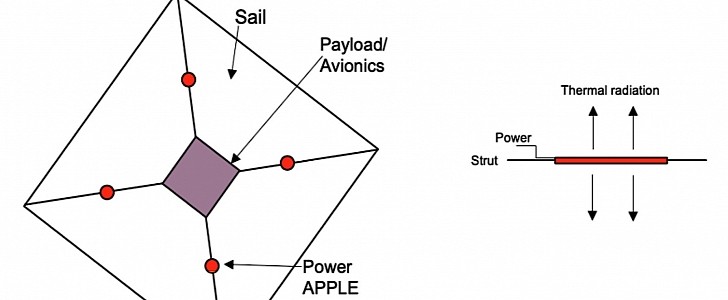If there is one thing we can say about space exploration, it is that this field of human enterprise sure is packed with crazy ideas. We’ve explored a bunch of them this April during autoevolution’s Space Month and in part thanks to NASA’s recently-announced Innovative Advanced Concepts (NIAC) program. And we’re not nearly done.
Coming today from the NIAC world is something called APPLE. That’s not the Apple you think, but short for Atomic Planar Power for Lightweight Exploration. We know, that doesn’t explain much, but read on.
The concept, created by Joseph Nemanick from the Aerospace Corporation, is described as “an enabling architecture for deep solar system missions on low mass, fast transit space platforms.“ Coupling the power of solar sails with a radiation-hard battery could push a spacecraft for great distances in a very short time.
For instance, the author behind the idea says a spaceship using APPLE could cover the distance to Jupiter in six months. That’s 811 million km (504 million miles), and just to put things into perspective, it took Perseverance seven months to cover the 290 million km (180 million miles) distance to Mars.
Similarly, it would take this hypothetical craft one year to reach Saturn and four to hit Pluto—again for reference, it took New Horizons 9.5 years to reach the non-planet.
To get places fast, APPLE relies on “a layered structure of radioisotope material backed with layers of solid-state, radiation-hard battery and thermal-to-electrical conversion technology.”
According to Nemanick, work on a radiation-hard battery is already underway at the hands of the Oak Ridge National Labs (ORNL) and the Aerospace Corporation, but no deadline as to when we should get a final design was announced.
Also, when picking the NIAC projects, NASA said that inclusion in the program doesn’t automatically mean any of the hardware will become part of some future mission.
The concept, created by Joseph Nemanick from the Aerospace Corporation, is described as “an enabling architecture for deep solar system missions on low mass, fast transit space platforms.“ Coupling the power of solar sails with a radiation-hard battery could push a spacecraft for great distances in a very short time.
For instance, the author behind the idea says a spaceship using APPLE could cover the distance to Jupiter in six months. That’s 811 million km (504 million miles), and just to put things into perspective, it took Perseverance seven months to cover the 290 million km (180 million miles) distance to Mars.
Similarly, it would take this hypothetical craft one year to reach Saturn and four to hit Pluto—again for reference, it took New Horizons 9.5 years to reach the non-planet.
To get places fast, APPLE relies on “a layered structure of radioisotope material backed with layers of solid-state, radiation-hard battery and thermal-to-electrical conversion technology.”
According to Nemanick, work on a radiation-hard battery is already underway at the hands of the Oak Ridge National Labs (ORNL) and the Aerospace Corporation, but no deadline as to when we should get a final design was announced.
Also, when picking the NIAC projects, NASA said that inclusion in the program doesn’t automatically mean any of the hardware will become part of some future mission.

